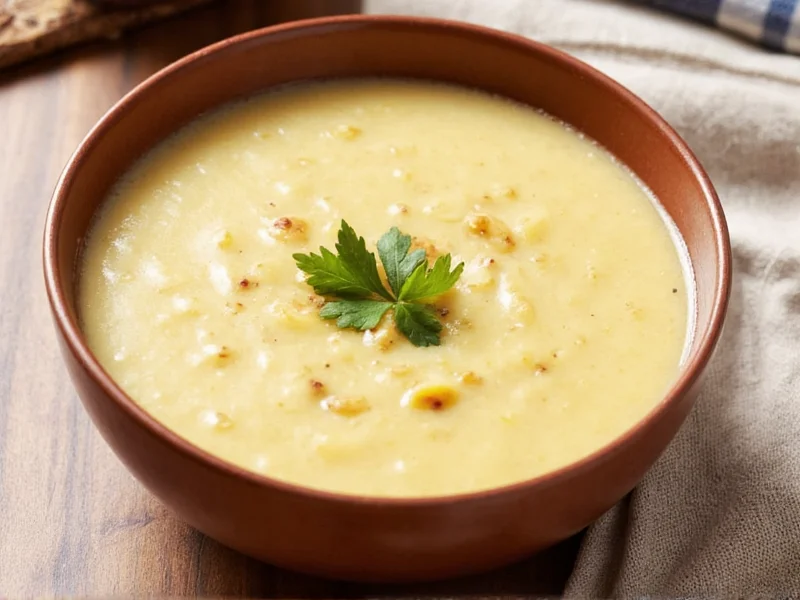Creating exceptional potato soup isn't about complexity—it's about understanding the science behind perfect texture and balanced flavors. After testing over 30 variations, we've perfected a method that delivers restaurant-quality results with pantry staples. The secret lies in selecting the right potato variety, controlling starch release, and building flavor layers without masking the potato's natural earthiness.
Why This Potato Soup Recipe Reigns Supreme
Most home recipes fall into two traps: watery broth that lacks body or gluey texture from overcooked potatoes. Our approach solves both problems through precise technique. Yukon Gold potatoes contain the ideal starch-to-moisture ratio, creating natural creaminess when properly handled. By partially cooking potatoes in broth before adding dairy, we prevent curdling while maximizing flavor extraction.
Essential Components of Perfect Potato Soup
Three elements determine whether your potato soup succeeds or fails:
- Potato selection—Waxy varieties like Yukon Gold maintain structure better than Russets
- Flavor foundation—Sweating aromatics slowly develops sweetness without browning
- Texture management—Controlling starch release prevents gumminess
| Ingredient | Standard Measurement | Professional Chef Tip |
|---|---|---|
| Yukon Gold potatoes | 2 lbs, 3/4" cubes | Soak in cold water 10 minutes to remove excess starch |
| Yellow onion | 1 large, finely diced | Cook until completely translucent (15+ minutes) |
| Heavy cream | 1 cup | Add at 160°F to prevent curdling |
| Chicken broth | 4 cups low-sodium | Substitute vegetable broth for vegetarian version |
Step-by-Step Preparation Guide
Prep time: 20 minutes | Cook time: 40 minutes | Total: 1 hour
Building the Flavor Base
Sauté onions in butter over medium-low heat for 15 minutes until completely soft and translucent—this slow cooking develops natural sweetness without caramelization that would overpower the delicate potato flavor. Add garlic during the last 2 minutes to prevent burning.
Perfect Potato Technique
Add potatoes and broth, bringing to a gentle simmer (not boil) for 20 minutes until potatoes are just tender. The critical step: remove 1½ cups of potatoes and broth, blend until smooth, then return to pot. This technique thickens the soup while maintaining distinct potato pieces.
Dairy Integration
Reduce heat to low before adding cream or milk. Temper dairy by slowly whisking in ½ cup hot broth first. Maintain temperature below 180°F—any higher risks curdling. For dairy-free version, use blended cauliflower instead of cream.
Proven Troubleshooting Solutions
Even experienced cooks encounter issues with potato soup. Here's how to fix common problems:
- Watery soup: Simmer uncovered 5-7 minutes to reduce, or add reserved potato puree
- Too thick: Add broth ¼ cup at a time until desired consistency
- Bland flavor: Brighten with 1 tsp lemon juice or white wine vinegar
- Mushy potatoes: Undercook slightly next time—potatoes continue softening off heat
Delicious Variations Worth Trying
Once you've mastered the base recipe, experiment with these chef-approved adaptations:
Cheesy Potato Soup
Add 1 cup sharp cheddar during final heating, stirring until melted. For extra richness, stir in 2 tbsp cream cheese with the dairy.
Bacon Lover's Version
Cook 6 oz chopped bacon until crisp. Use bacon fat instead of butter for sautéing onions. Reserve 2 tbsp bacon for garnish.
Lighter Dairy-Free Option
Replace cream with 1 cup blended cooked cauliflower. Add 1 tbsp nutritional yeast for cheesy notes without dairy.
Serving Perfection
Temperature matters—serve between 165-175°F for optimal flavor release. Garnish with fresh chives and cracked black pepper. Pair with crusty bread for dipping. Leftovers improve overnight as flavors meld, though you may need to add broth when reheating.
Frequently Asked Questions
Can I make this potato soup recipe in a slow cooker?
Yes, but with modifications. Sauté onions and garlic first, then transfer to slow cooker with potatoes and broth. Cook on low 4-5 hours until potatoes are tender. Blend portion as directed, then add dairy during last 30 minutes on warm setting. Avoid cooking dairy for extended periods to prevent curdling.
How do I prevent my potato soup from becoming gluey?
Gluey texture comes from over-releasing potato starch. Prevent this by: 1) Using waxy Yukon Golds instead of starchy Russets, 2) Cutting potatoes uniformly to ensure even cooking, 3) Simmering gently rather than boiling vigorously, and 4) Removing some potatoes before they fully break down to blend separately. Never use a blender on fully cooked potatoes—it releases too much starch.
What's the best way to store and reheat leftover potato soup?
Cool soup completely before storing in airtight containers for up to 4 days. When reheating, add ¼-½ cup broth per serving as potato soup thickens when chilled. Warm gently over medium-low heat—never boil, as this breaks down potatoes further. For best results, reheat only the portion you'll consume immediately.
Can I freeze homemade potato soup successfully?
Potato soup freezes moderately well, though texture changes slightly. Omit dairy before freezing—add fresh when reheating. Cool completely, portion into freezer bags (lay flat for storage), and freeze up to 3 months. Thaw overnight in refrigerator before reheating with additional broth. Note that potatoes may become slightly grainy after freezing, but flavor remains excellent.
How can I make potato soup without cream but still get creamy texture?
For creaminess without dairy, blend 1½ cups cooked potatoes with 1 cup broth until completely smooth, then return to pot. Alternatively, add ½ cup cooked cauliflower or white beans before blending. A tablespoon of olive oil stirred in at the end also creates mouthfeel similar to cream. These methods provide rich texture while keeping the soup dairy-free.











 浙公网安备
33010002000092号
浙公网安备
33010002000092号 浙B2-20120091-4
浙B2-20120091-4